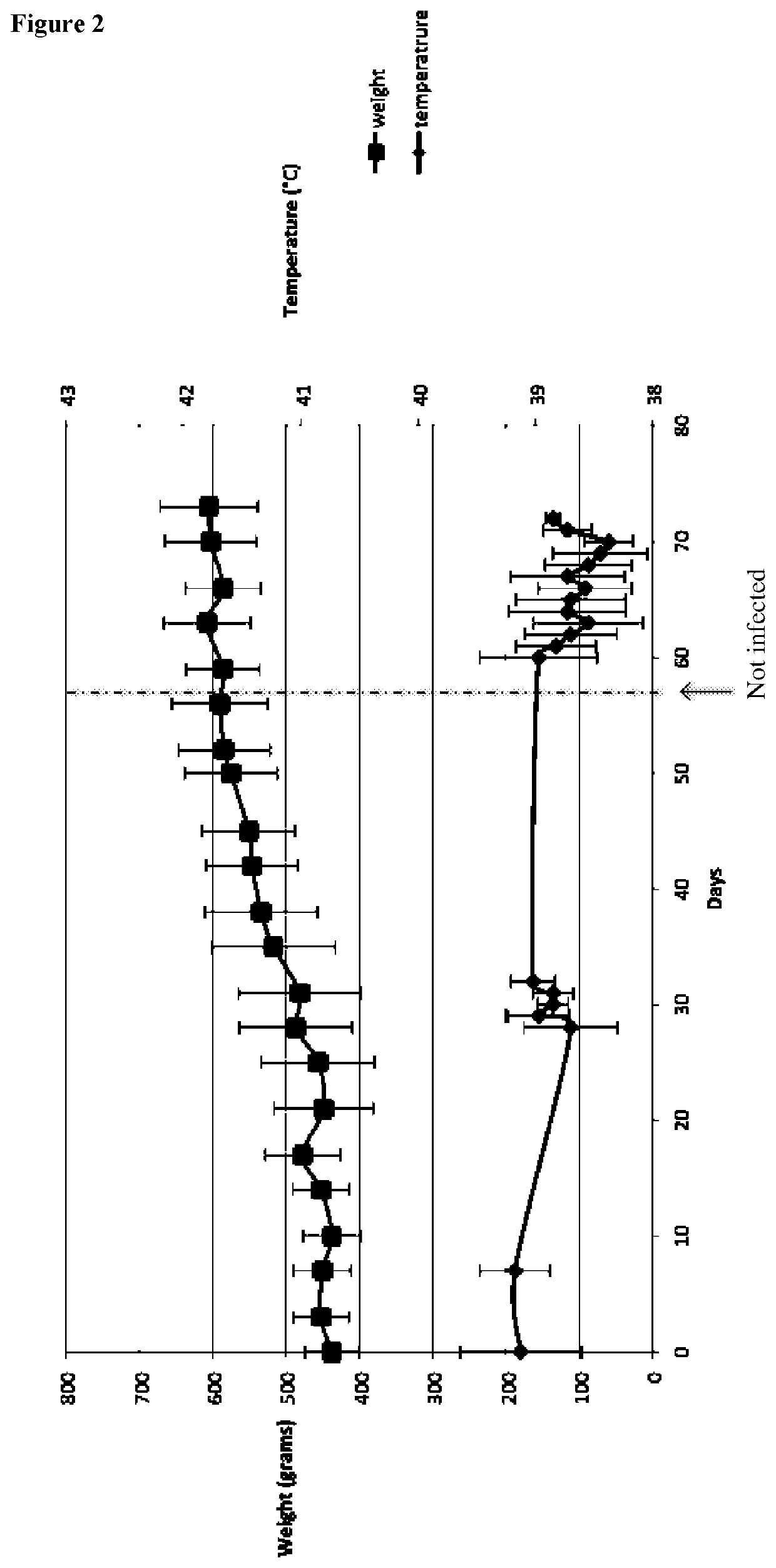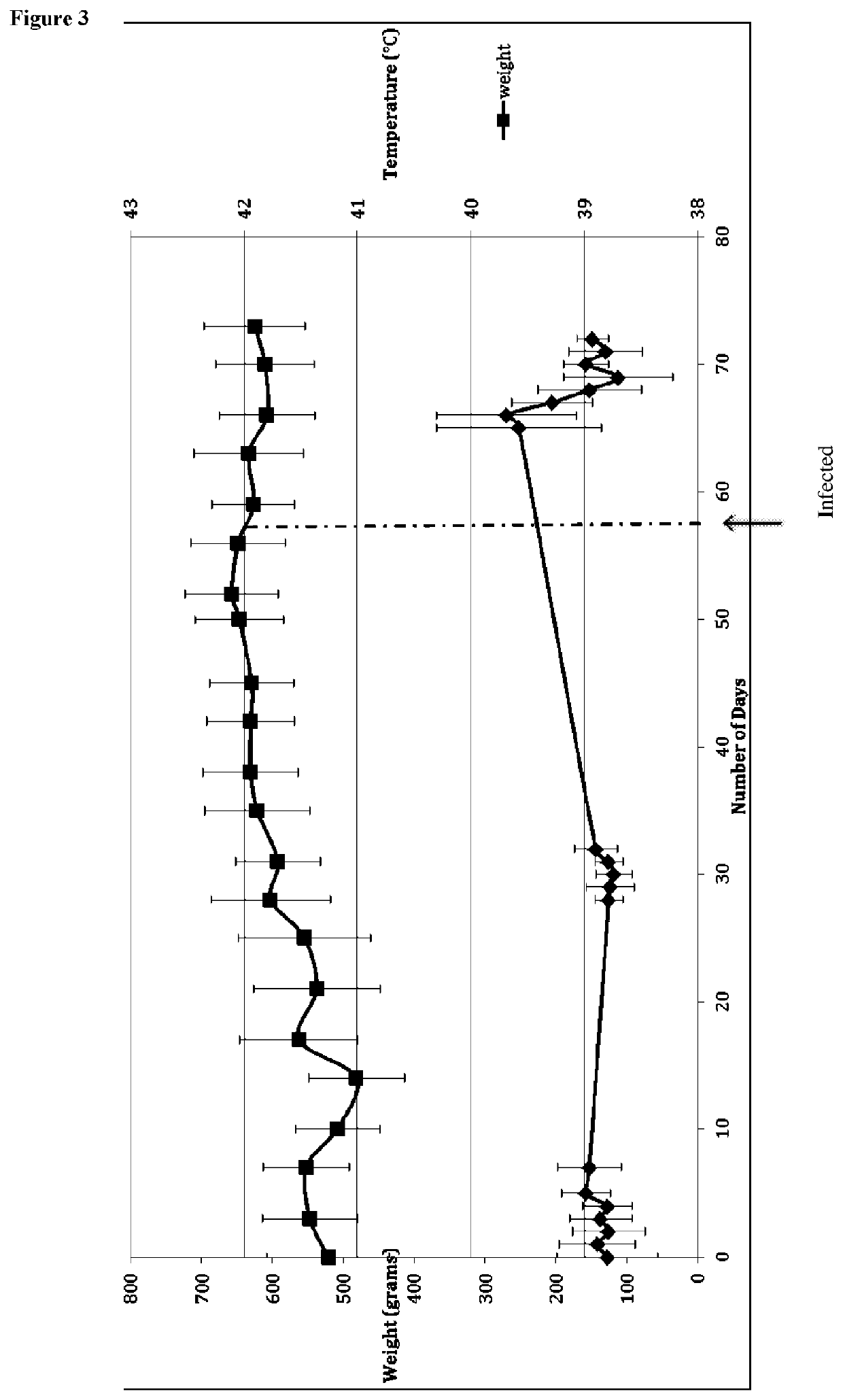Vaccine
a technology of q-vax® and a vaccine is applied in the field of vaccines, which can solve the problems of high mortality rate, significant toxicity of q-vax®, and difficult diagnosis, and achieve the effects of reducing the risk of infection, and improving the safety of us
- Summary
- Abstract
- Description
- Claims
- Application Information
AI Technical Summary
Benefits of technology
Problems solved by technology
Method used
Image
Examples
example 1
Cultivation and Purification of Coxiella burnetii Cells
[0069]C. burnetii strain Nine Mile, RSA 493, (Davis and Cox, Public Health Rep. 53:2259-2276, 1938) serologically in phase I (yolk sack passage 3 in our Laboratory) was propagated in six-seven-day-old embryonated hens' eggs. For inoculation, the stock suspension of C. burnetii infected yolk sacs (40%) in phosphate buffered saline (PBS) was used. The inoculum was from the Laboratory for Diagnosis and Prevention of Rickettsial and Chlamydial Infections, Institute of Virology, Slovak Academy of Sciences, Bratislava, Slovakia. The embryonated eggs were inoculated with a diluted infectious stock suspension (0.25 ml each) that resulted in the highest embryos' death 7-8 days post-inoculation. The inoculated eggs were incubated at 35.5° C. and relative humidity of 50-90%. From day 3, incubation was monitored twice daily with an ovoscope and evaluation of the yolk sacs by Gimenez-stained smears under a microscope. The yolk sacs with embr...
example 2
Isolation and Detoxification of C. burnetii Lipopolysaccharide
[0071]C. burnetii cells (1.5 g) were suspended in 50 mM Tris-HCl buffer (150 ml, pH 7.5) and treated simultaneously with RNase (EC 3.1.27.5) and DNase (EC 3.1.27.1), both from bovine pancreas (Boehringer) at 37° C. for 16 hours. The cells were then treated with trypsin 1:250 (EC 232-650-8; Sigma) at 37° C. for 90 minutes followed by proteinase K from Tritirachium album (EC 3.4.21.14; Sigma) at 37° C. for 16 hours. After enzyme treatments, the cell suspension was centrifuged at 14,000×g, 10° C. for 50 minutes and the sediment was washed with acetone. Cells were extracted with chloroform-methanol (2:1, v / v) at 20° C. for 3 hours to remove phospholipids. The extraction was repeated with the fresh solvent mixture for 2 hours. The cell suspension was centrifuged at 3,000×g, 20° C. for 20 minutes and the sediment was suspended in preheated distilled water (150 ml, 68° C.) and extracted with an equal volume of aqueous 90% phenol...
example 3
Conjugation of Delipidated O-Specific Polysaccharide to a Carrier Protein
[0074]Detoxified (delipidated) Q Fever O-specific polysaccharide (dOSP), derived from its lipopolysaccharide (LPS) by removal of the toxic lipid A component, was conjugated to tetanus toxoid as a carrier protein. The primary purpose of the carrier protein is to improve the immunogenicity of the dOSP and to induce a T-cell dependent immune response when injected into animals.
[0075]Purified dOSP (Example 2) was activated with 1-cyano-4-dimethylaminopyridinium tetrafluoroborate (CDAP; Sigma) and derivatized with adipic acid dihydrazide (ADH; Sigma) using a modification of the method previously described (Konadu et al., 1996). Briefly the methodology was as follows dOSP was diluted to 5 mg / mL (2.0 mg / mL after addition of CDAP and ADH) in purified water and the pH adjusted to 5.1 to 5.5. CDAP (100 mg / ml in acetonitrile) was added to a final concentration of 2.0 mg / mL and held at room temperature (RT) for 2 minutes. ...
PUM
| Property | Measurement | Unit |
|---|---|---|
| weight | aaaaa | aaaaa |
| concentration | aaaaa | aaaaa |
| concentration | aaaaa | aaaaa |
Abstract
Description
Claims
Application Information
 Login to View More
Login to View More - R&D
- Intellectual Property
- Life Sciences
- Materials
- Tech Scout
- Unparalleled Data Quality
- Higher Quality Content
- 60% Fewer Hallucinations
Browse by: Latest US Patents, China's latest patents, Technical Efficacy Thesaurus, Application Domain, Technology Topic, Popular Technical Reports.
© 2025 PatSnap. All rights reserved.Legal|Privacy policy|Modern Slavery Act Transparency Statement|Sitemap|About US| Contact US: help@patsnap.com



